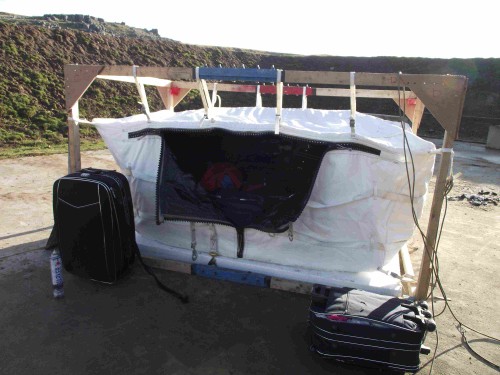As someone who flies a lot, I try not to fret too much about whether or not there could be a bomb on my plane. But the reality is, there’s currently no way for authorities to make sure that the luggage and cargo put on a plane is 100% bomb-free.
So in putting together this story for msnbc.com’s Overhead Bin, I was glad to learn about efforts underway to build a better bomb-proof bag.

Testing the bomb-proof bag. Photo courtesy of the University of Sheffield
A team of international engineers has been busy blowing up baggage in an effort to perfect a flexible, bomb-proof cargo container for airplanes.
The goal is to replace the large, expensive cases currently used by some airlines and prevent or minimize the damage that might result from an explosion in an aircraft cargo hold.
“Israel puts one [hard container] on each El Al flight where high risk luggage is stored,” said Jeff Price, an associate professor and aviation security expert at the Metropolitan State College of Denver. “But the argument against their use is weight. If you increase the weight of the plane, you must decrease it somewhere else. In the eyes of the airlines, then passengers, cargo or mail – i.e. ‘revenue,’ – must be reduced.”
That’s why the lighter “Fly-Bag,” being tested at The University of Sheffield in England, is drawing attention.
“Airlines have been reticent to fly with hardened containers due to their high capital and ongoing cost. We should be able to offer something cheaper,” said Jim Warren of the university’s department of civil and structural engineering.
The Fly-Bag is made of “multiple layers of lightweight materials, composites and membranes,” including fabric impregnated with shear thickening fluids that increase their viscosity in response to impact, Warren said. Suitcases and cargo are placed inside the larger bag before being loaded onto an airplane. If a bomb detonates inside one piece of luggage, the Fly-Bag is designed to absorb the force of the explosion.
“To test it, we built a full scale prototype, filled it with suitcases containing clothes, towels and other items we bought at a left luggage auction in the UK. We put a surrogate IED [improvised explosive device] in one bag and blew it up,” said Warren, who expects the Fly-Bag to be on market within one to two years.
“I think this type of product has good potential application for select threats,” said Solomon Wong, executive vice president of InterVISTAS, a travel and transportation consulting firm. He notes that other products involving venting and foam or curtain-wall systems to absorb the shock of explosive devices are also being looked at, but these can’t be immediately deployed “due to some unresolved safety issues.”
And while the Fly-Bag may turn out to be a better bomb-proof cargo container, it still does not address explosives terrorists may bring onboard in carry-on luggage or, as officials warned last week, implanted on passengers flying into the U.S. from abroad.
To address that security threat, the Transportation Security Administration said “passengers flying from international locations to U.S. destinations may notice additional security measures in place,” that could include more pat-downs, bag screenings and questioning.
Wong doesn’t foresee a day when passengers will be placed in bomb-proof Fly-Bags, but he does think we’ll see bomb-resistant airplanes, so that “a blast in the cabin of an aircraft or hold does not result in catastrophic failure of the fuselage.”
Thanks for visiting Stuck at the Airport. Subscribe to get daily travel tidbits. And follow me on Twitter at @hbaskas and Instagram.